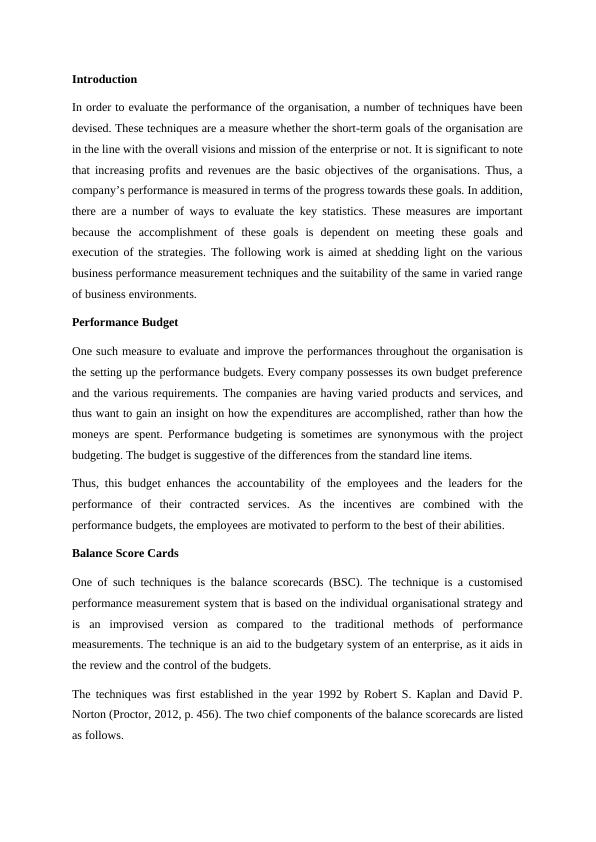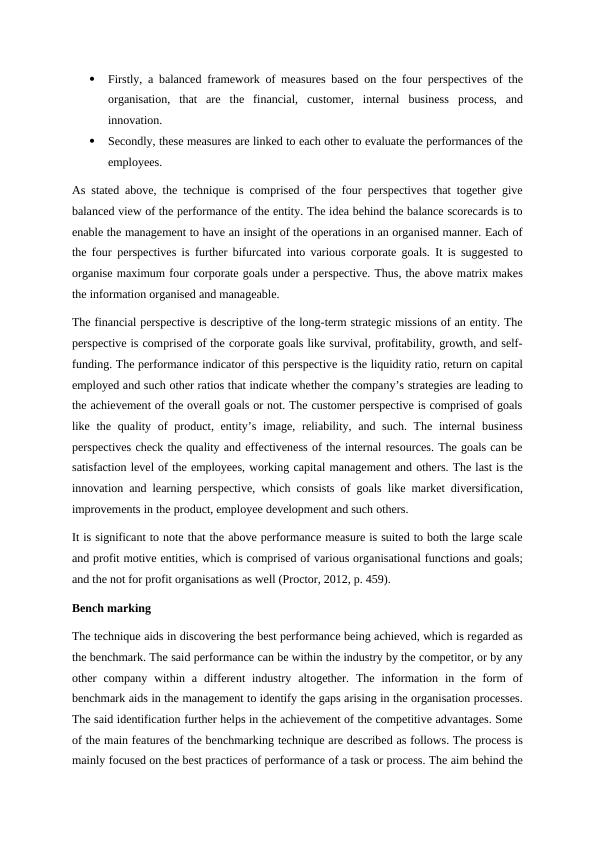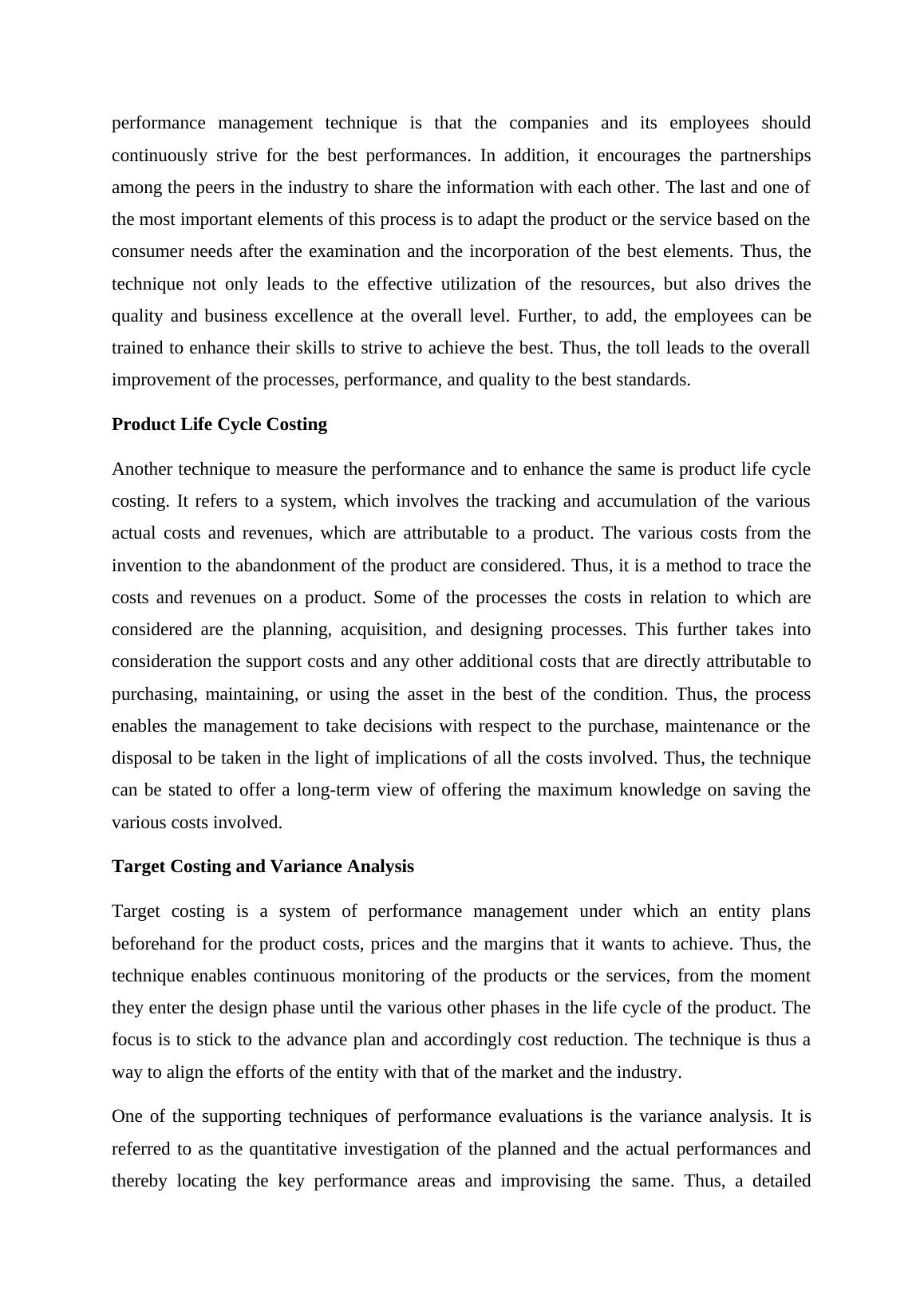Strategic Management Assignment PDF
6 Pages2019 Words31 Views
Added on 2021-12-22
Strategic Management Assignment PDF
Added on 2021-12-22
ShareRelated Documents
Introduction
In order to evaluate the performance of the organisation, a number of techniques have been
devised. These techniques are a measure whether the short-term goals of the organisation are
in the line with the overall visions and mission of the enterprise or not. It is significant to note
that increasing profits and revenues are the basic objectives of the organisations. Thus, a
company’s performance is measured in terms of the progress towards these goals. In addition,
there are a number of ways to evaluate the key statistics. These measures are important
because the accomplishment of these goals is dependent on meeting these goals and
execution of the strategies. The following work is aimed at shedding light on the various
business performance measurement techniques and the suitability of the same in varied range
of business environments.
Performance Budget
One such measure to evaluate and improve the performances throughout the organisation is
the setting up the performance budgets. Every company possesses its own budget preference
and the various requirements. The companies are having varied products and services, and
thus want to gain an insight on how the expenditures are accomplished, rather than how the
moneys are spent. Performance budgeting is sometimes are synonymous with the project
budgeting. The budget is suggestive of the differences from the standard line items.
Thus, this budget enhances the accountability of the employees and the leaders for the
performance of their contracted services. As the incentives are combined with the
performance budgets, the employees are motivated to perform to the best of their abilities.
Balance Score Cards
One of such techniques is the balance scorecards (BSC). The technique is a customised
performance measurement system that is based on the individual organisational strategy and
is an improvised version as compared to the traditional methods of performance
measurements. The technique is an aid to the budgetary system of an enterprise, as it aids in
the review and the control of the budgets.
The techniques was first established in the year 1992 by Robert S. Kaplan and David P.
Norton (Proctor, 2012, p. 456). The two chief components of the balance scorecards are listed
as follows.
In order to evaluate the performance of the organisation, a number of techniques have been
devised. These techniques are a measure whether the short-term goals of the organisation are
in the line with the overall visions and mission of the enterprise or not. It is significant to note
that increasing profits and revenues are the basic objectives of the organisations. Thus, a
company’s performance is measured in terms of the progress towards these goals. In addition,
there are a number of ways to evaluate the key statistics. These measures are important
because the accomplishment of these goals is dependent on meeting these goals and
execution of the strategies. The following work is aimed at shedding light on the various
business performance measurement techniques and the suitability of the same in varied range
of business environments.
Performance Budget
One such measure to evaluate and improve the performances throughout the organisation is
the setting up the performance budgets. Every company possesses its own budget preference
and the various requirements. The companies are having varied products and services, and
thus want to gain an insight on how the expenditures are accomplished, rather than how the
moneys are spent. Performance budgeting is sometimes are synonymous with the project
budgeting. The budget is suggestive of the differences from the standard line items.
Thus, this budget enhances the accountability of the employees and the leaders for the
performance of their contracted services. As the incentives are combined with the
performance budgets, the employees are motivated to perform to the best of their abilities.
Balance Score Cards
One of such techniques is the balance scorecards (BSC). The technique is a customised
performance measurement system that is based on the individual organisational strategy and
is an improvised version as compared to the traditional methods of performance
measurements. The technique is an aid to the budgetary system of an enterprise, as it aids in
the review and the control of the budgets.
The techniques was first established in the year 1992 by Robert S. Kaplan and David P.
Norton (Proctor, 2012, p. 456). The two chief components of the balance scorecards are listed
as follows.

Firstly, a balanced framework of measures based on the four perspectives of the
organisation, that are the financial, customer, internal business process, and
innovation.
Secondly, these measures are linked to each other to evaluate the performances of the
employees.
As stated above, the technique is comprised of the four perspectives that together give
balanced view of the performance of the entity. The idea behind the balance scorecards is to
enable the management to have an insight of the operations in an organised manner. Each of
the four perspectives is further bifurcated into various corporate goals. It is suggested to
organise maximum four corporate goals under a perspective. Thus, the above matrix makes
the information organised and manageable.
The financial perspective is descriptive of the long-term strategic missions of an entity. The
perspective is comprised of the corporate goals like survival, profitability, growth, and self-
funding. The performance indicator of this perspective is the liquidity ratio, return on capital
employed and such other ratios that indicate whether the company’s strategies are leading to
the achievement of the overall goals or not. The customer perspective is comprised of goals
like the quality of product, entity’s image, reliability, and such. The internal business
perspectives check the quality and effectiveness of the internal resources. The goals can be
satisfaction level of the employees, working capital management and others. The last is the
innovation and learning perspective, which consists of goals like market diversification,
improvements in the product, employee development and such others.
It is significant to note that the above performance measure is suited to both the large scale
and profit motive entities, which is comprised of various organisational functions and goals;
and the not for profit organisations as well (Proctor, 2012, p. 459).
Bench marking
The technique aids in discovering the best performance being achieved, which is regarded as
the benchmark. The said performance can be within the industry by the competitor, or by any
other company within a different industry altogether. The information in the form of
benchmark aids in the management to identify the gaps arising in the organisation processes.
The said identification further helps in the achievement of the competitive advantages. Some
of the main features of the benchmarking technique are described as follows. The process is
mainly focused on the best practices of performance of a task or process. The aim behind the
organisation, that are the financial, customer, internal business process, and
innovation.
Secondly, these measures are linked to each other to evaluate the performances of the
employees.
As stated above, the technique is comprised of the four perspectives that together give
balanced view of the performance of the entity. The idea behind the balance scorecards is to
enable the management to have an insight of the operations in an organised manner. Each of
the four perspectives is further bifurcated into various corporate goals. It is suggested to
organise maximum four corporate goals under a perspective. Thus, the above matrix makes
the information organised and manageable.
The financial perspective is descriptive of the long-term strategic missions of an entity. The
perspective is comprised of the corporate goals like survival, profitability, growth, and self-
funding. The performance indicator of this perspective is the liquidity ratio, return on capital
employed and such other ratios that indicate whether the company’s strategies are leading to
the achievement of the overall goals or not. The customer perspective is comprised of goals
like the quality of product, entity’s image, reliability, and such. The internal business
perspectives check the quality and effectiveness of the internal resources. The goals can be
satisfaction level of the employees, working capital management and others. The last is the
innovation and learning perspective, which consists of goals like market diversification,
improvements in the product, employee development and such others.
It is significant to note that the above performance measure is suited to both the large scale
and profit motive entities, which is comprised of various organisational functions and goals;
and the not for profit organisations as well (Proctor, 2012, p. 459).
Bench marking
The technique aids in discovering the best performance being achieved, which is regarded as
the benchmark. The said performance can be within the industry by the competitor, or by any
other company within a different industry altogether. The information in the form of
benchmark aids in the management to identify the gaps arising in the organisation processes.
The said identification further helps in the achievement of the competitive advantages. Some
of the main features of the benchmarking technique are described as follows. The process is
mainly focused on the best practices of performance of a task or process. The aim behind the

performance management technique is that the companies and its employees should
continuously strive for the best performances. In addition, it encourages the partnerships
among the peers in the industry to share the information with each other. The last and one of
the most important elements of this process is to adapt the product or the service based on the
consumer needs after the examination and the incorporation of the best elements. Thus, the
technique not only leads to the effective utilization of the resources, but also drives the
quality and business excellence at the overall level. Further, to add, the employees can be
trained to enhance their skills to strive to achieve the best. Thus, the toll leads to the overall
improvement of the processes, performance, and quality to the best standards.
Product Life Cycle Costing
Another technique to measure the performance and to enhance the same is product life cycle
costing. It refers to a system, which involves the tracking and accumulation of the various
actual costs and revenues, which are attributable to a product. The various costs from the
invention to the abandonment of the product are considered. Thus, it is a method to trace the
costs and revenues on a product. Some of the processes the costs in relation to which are
considered are the planning, acquisition, and designing processes. This further takes into
consideration the support costs and any other additional costs that are directly attributable to
purchasing, maintaining, or using the asset in the best of the condition. Thus, the process
enables the management to take decisions with respect to the purchase, maintenance or the
disposal to be taken in the light of implications of all the costs involved. Thus, the technique
can be stated to offer a long-term view of offering the maximum knowledge on saving the
various costs involved.
Target Costing and Variance Analysis
Target costing is a system of performance management under which an entity plans
beforehand for the product costs, prices and the margins that it wants to achieve. Thus, the
technique enables continuous monitoring of the products or the services, from the moment
they enter the design phase until the various other phases in the life cycle of the product. The
focus is to stick to the advance plan and accordingly cost reduction. The technique is thus a
way to align the efforts of the entity with that of the market and the industry.
One of the supporting techniques of performance evaluations is the variance analysis. It is
referred to as the quantitative investigation of the planned and the actual performances and
thereby locating the key performance areas and improvising the same. Thus, a detailed
continuously strive for the best performances. In addition, it encourages the partnerships
among the peers in the industry to share the information with each other. The last and one of
the most important elements of this process is to adapt the product or the service based on the
consumer needs after the examination and the incorporation of the best elements. Thus, the
technique not only leads to the effective utilization of the resources, but also drives the
quality and business excellence at the overall level. Further, to add, the employees can be
trained to enhance their skills to strive to achieve the best. Thus, the toll leads to the overall
improvement of the processes, performance, and quality to the best standards.
Product Life Cycle Costing
Another technique to measure the performance and to enhance the same is product life cycle
costing. It refers to a system, which involves the tracking and accumulation of the various
actual costs and revenues, which are attributable to a product. The various costs from the
invention to the abandonment of the product are considered. Thus, it is a method to trace the
costs and revenues on a product. Some of the processes the costs in relation to which are
considered are the planning, acquisition, and designing processes. This further takes into
consideration the support costs and any other additional costs that are directly attributable to
purchasing, maintaining, or using the asset in the best of the condition. Thus, the process
enables the management to take decisions with respect to the purchase, maintenance or the
disposal to be taken in the light of implications of all the costs involved. Thus, the technique
can be stated to offer a long-term view of offering the maximum knowledge on saving the
various costs involved.
Target Costing and Variance Analysis
Target costing is a system of performance management under which an entity plans
beforehand for the product costs, prices and the margins that it wants to achieve. Thus, the
technique enables continuous monitoring of the products or the services, from the moment
they enter the design phase until the various other phases in the life cycle of the product. The
focus is to stick to the advance plan and accordingly cost reduction. The technique is thus a
way to align the efforts of the entity with that of the market and the industry.
One of the supporting techniques of performance evaluations is the variance analysis. It is
referred to as the quantitative investigation of the planned and the actual performances and
thereby locating the key performance areas and improvising the same. Thus, a detailed

End of preview
Want to access all the pages? Upload your documents or become a member.
Related Documents
Management Accounting Tools Assignmentlg...
|10
|2622
|258
Analysis and Implication of Balance Scorecard in Management Accountinglg...
|9
|2001
|106
Advantages and Critique of Balanced Scorecard in Management Accountinglg...
|7
|1086
|454
(Solution) Balance Score Card : PDFlg...
|10
|2136
|104
Management Accounting Balanced Scorecardlg...
|14
|4478
|27
Importance of Balanced Scorecard and Decentralized Decision-Making Authority in Business Organizationslg...
|8
|2040
|75
